Top Microcontroller Embedded Systems Ideas for Innovators
Category: Embedded Systems
Unlock Cutting-Edge Microcontroller Embedded Systems Ideas
Whether you're a tech enthusiast, hobbyist, or seasoned developer, finding fresh and practical microcontroller embedded systems ideas can be challenging amid countless sources. You likely landed here because you want more than generic project suggestions — you want actionable, innovative concepts that leverage your skills in Python, C/C++, and embedded development with platforms like Raspberry Pi. This post understands your drive for creative, real-world projects that push boundaries while deepening your programming mastery. We'll walk through diverse embedded system ideas that range from beginner-friendly DIY gadgets to advanced autonomous systems, all structured to spark inspiration and expand your capabilities. Unlike other posts that offer superficial tips, this guide prioritizes practical applications and implementation insights tailored to your expertise. Dive in to discover projects that make your microcontroller work smarter, connectedly, and creatively. Let’s explore ideas that will fuel your next innovative build and help you master embedded systems development from the ground up.
- Unlock Cutting-Edge Microcontroller Embedded Systems Ideas
- Overview of Microcontroller Embedded Systems and Their Applications
- Essential Components and Tools for Developing Embedded Systems
- Beginner-Friendly Embedded Project Ideas to Jumpstart Your Journey
- Intermediate Projects Incorporating Sensors and Communication Protocols
- Advanced Embedded Systems Projects Leveraging AI and IoT Integration
- Programming Strategies in Python and C/C++ for Embedded Systems
- Power Management and Optimization Techniques for Embedded Designs
- Debugging and Testing Methods for Reliable Embedded System Projects
- Case Studies of Creative Real-World Embedded Projects
- Resources and Communities to Support Your Embedded Systems Development
Overview of Microcontroller Embedded Systems and Their Applications
Embedded systems are specialized computing systems designed to perform dedicated functions or tasks within larger mechanical or electrical systems. Unlike general-purpose computers, embedded systems are optimized for specific control, monitoring, or data processing roles and often operate in real-time environments. At the heart of these systems lies the microcontroller, a compact integrated circuit that combines a processor core, memory, and programmable input/output peripherals on a single chip.
Microcontrollers empower embedded systems to interact seamlessly with the physical world through sensors, actuators, and communication interfaces. Their wide adoption spans industries such as consumer electronics, automotive, healthcare, industrial automation, and smart home technology. From thermostats and wearable devices to complex robotic controls and autonomous drones, embedded microcontroller systems enable smarter, more efficient, and responsive technologies.
Key reasons why microcontroller embedded systems are foundational in modern innovation include:
- Low-power operation enabling battery-powered and portable applications.
- Cost-effectiveness due to integrated functionalities and minimal external components.
- Real-time responsiveness critical for safety and precision tasks.
- Programmability and flexibility supporting diverse uses and rapid prototyping.
Understanding the fundamental role of microcontrollers within embedded systems sets the groundwork for exploring creative project ideas that harness their full potential while enhancing your skills in Python, C/C++, and hardware interfacing on platforms like Raspberry Pi.
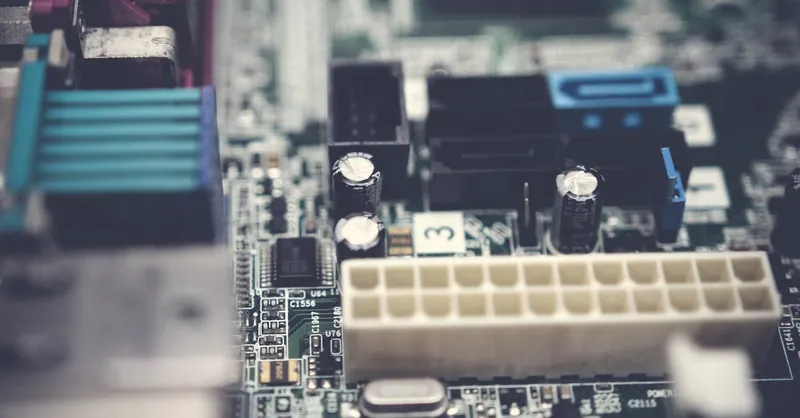
Image courtesy of Pok Rie
Essential Components and Tools for Developing Embedded Systems
Developing robust and innovative microcontroller embedded systems requires a blend of carefully selected hardware components and software tools that streamline coding, debugging, and deployment. At the core, choosing the right microcontroller board such as the Arduino Uno, Raspberry Pi Pico, or more advanced ARM-based MCUs ensures you have the necessary processing power, I/O capabilities, and community support for your project. Complementing the microcontroller, selecting appropriate sensors (e.g., temperature, humidity, motion, light) and actuators (motors, relays, LEDs) allows your system to interact effectively with the environment, enabling data acquisition and real-world control.
On the software side, development environments like Arduino IDE, PlatformIO, or Visual Studio Code equipped with embedded extensions provide comprehensive platforms for writing, compiling, and uploading firmware using Python, C, or C++. Integrated debuggers and serial monitors play a crucial role in tracing program execution and diagnosing hardware communication issues, improving development efficiency and reliability. Additionally, libraries and frameworks tailored to specific hardware modules help accelerate prototyping and reduce low-level coding effort, making these tools indispensable for embedded systems developers aiming to create cutting-edge projects.
Key Hardware Components:
- Microcontroller Boards: Arduino, Raspberry Pi Pico, ESP32, STM32
- Sensors: Temperature sensors (DS18B20), accelerometers (MPU6050), proximity sensors, gas sensors
- Actuators: Servo motors, stepper motors, relays, OLED displays
- Power Supplies: Batteries, voltage regulators, USB power modules
- Communication Modules: Wi-Fi (ESP8266), Bluetooth, Zigbee
Essential Software Tools:
- IDEs: Arduino IDE, PlatformIO, MPLAB X, Thonny (for Python)
- Compilers: GCC for ARM, AVR-GCC
- Debugging Tools: GDB-based debuggers, logic analyzers, serial monitors
- Version Control: Git integration for organized development
Mastering the synergy between these hardware components and software tools empowers you to build efficient, scalable embedded systems while honing valuable skills applicable throughout the embedded development lifecycle.
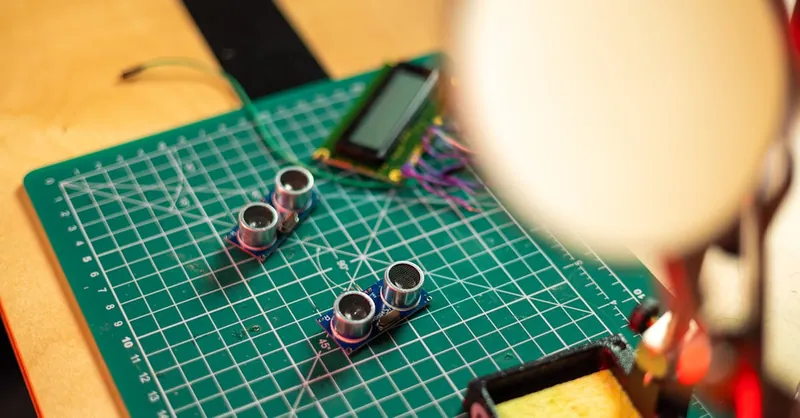
Image courtesy of ThisIsEngineering
Beginner-Friendly Embedded Project Ideas to Jumpstart Your Journey
Starting with simple and hands-on microcontroller projects is the ideal way to cement your understanding of embedded systems fundamentals while gaining confidence in programming with Python, C, or C++. These beginner-friendly designs focus on core concepts like sensor integration, actuator control, and real-time responsiveness, providing practical experience with widely used components and development tools.
1. LED Blinker: The Classic Introduction to Microcontroller Programming
A fundamental embedded system project is the LED blinker, which teaches you how to control digital outputs and work with timing functions. Using platforms like Arduino or Raspberry Pi Pico, you can write concise Python or C code to toggle an LED on and off at specified intervals, introducing you to concepts of GPIO manipulation, delay loops, and basic program structure. This project is perfect to get familiar with flashing LEDs, debugging techniques, and verifying hardware connections.
Example code snippet in C for Arduino:
void setup() {
pinMode(13, OUTPUT); // Initialize LED pin
}
void loop() {
digitalWrite(13, HIGH); // Turn LED on
delay(1000); // Wait 1 second
digitalWrite(13, LOW); // Turn LED off
delay(1000); // Wait 1 second
}
2. Temperature Monitor Using a DS18B20 Sensor
Building a basic temperature monitoring system introduces sensor reading, analog-to-digital data interpretation, and serial communication essentials. The DS18B20 digital temperature sensor is popular due to its simplicity and accuracy, easily interfaced with both Arduino and Raspberry Pi boards. Programming this project involves initializing the sensor, capturing temperature data, and outputting the results via serial port or a simple display module. This lays the groundwork for more complex environmental sensing and IoT applications.
Key skills developed:
- Sensor wiring and configuration
- Data acquisition and processing
- Serial communication and debugging
3. Basic Motor Control with PWM Signals
Controlling a small DC motor or a servo motor introduces you to power electronics interfacing and Pulse Width Modulation (PWM), a technique to vary motor speed or position. This project lets you practice configuring PWM outputs in your microcontroller, writing code to adjust duty cycles, and safely driving actuators with appropriate transistors or motor drivers. Beginners learn vital embedded system principles such as timing precision, current limitations, and system feedback.
Outline for project steps: 1. Connect motor driver circuit to microcontroller 2. Configure PWM output pin in code 3. Write functions to vary motor speed or angle 4. Test with user inputs or sensor feedback loops
Starting with these simple and tangible projects encourages iterative learning by focusing on foundational embedded system principles while gradually expanding your programming skills. Each project simultaneously builds practical expertise with microcontroller hardware, peripheral interfacing, and efficient coding patterns, all vital for more ambitious embedded system developments.
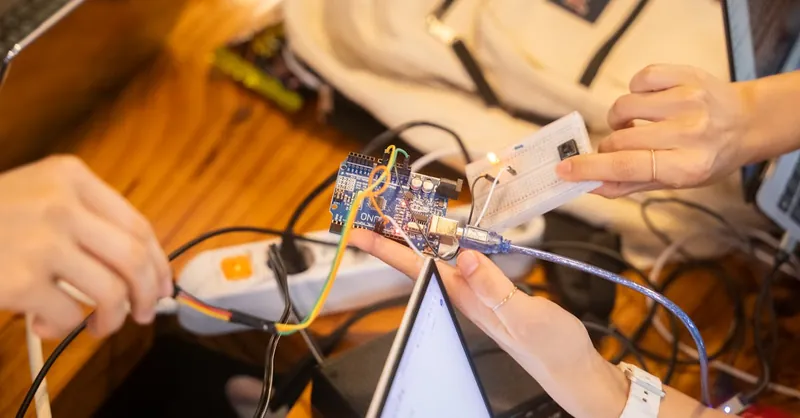
Image courtesy of Youn Seung Jin
Intermediate Projects Incorporating Sensors and Communication Protocols
Once you have mastered the basics, advancing to intermediate embedded system projects that blend sensor integration with communication protocols unlocks a new realm of functionality and connectivity. Utilizing components such as ultrasonic sensors, Bluetooth or WiFi modules, and establishing serial communication links enables you to build versatile systems for remote monitoring, automation, and data-driven decision-making.
Key Intermediate Project Ideas:
-
Ultrasonic Distance-Based Automation System
By interfacing an ultrasonic sensor (e.g., HC-SR04) with your microcontroller and combining it with actuators like servos or relays, you can develop automation systems that react to physical proximity. For example, an automatic door opener or a contactless water dispenser. Mastery of precise timing and pulse measurement is critical here, along with real-time processing of sensor data. -
Bluetooth-Enabled Home Environment Monitor
Integrate sensors measuring temperature, humidity, or air quality and transmit the collected data over Bluetooth (using modules like the HC-05 or BLE devices) to a smartphone app. This project involves both embedded programming and basic mobile app interfacing, teaching you how to manage wireless data transfer, pairing protocols, and low-energy communication standards essential for IoT applications. -
WiFi-Based Remote Data Logger with MQTT
Using WiFi modules such as the ESP8266 or ESP32, you can create embedded systems that send sensor data to cloud services or local servers via MQTT or HTTP protocols. This enables remote monitoring of environmental parameters, industrial processes, or agricultural fields in real time. This project enriches your understanding of network stacks, API integration, and asynchronous data transmission in embedded systems. -
Serial Communication Between Microcontroller and Raspberry Pi
Implementing UART or SPI communication protocols establishes reliable data exchange between microcontrollers and powerful platforms like Raspberry Pi. For instance, you can offload sensor data processing to the Raspberry Pi while the microcontroller handles low-level sensor readings and actuation. Developing a robust protocol, handling buffer overflows, and ensuring synchronization are critical skills sharpened here.
Why These Intermediate Projects Matter:
- They enhance your understanding of multi-component system integration, bridging sensors, actuators, and communication interfaces.
- Provide hands-on experience with real-world protocols like UART, SPI, Bluetooth, WiFi, and MQTT, foundational to modern embedded and IoT systems.
- Boost your skills in embedded networking, remote diagnostics, and automation logic, which are highly sought after in both hobbyist and professional embedded development.
- Prepare you to architect complex systems that are scalable, reliable, and capable of interacting seamlessly across devices and networks.
Tackling these intermediate projects deepens your embedded system toolkit by combining hardware mastery with communication protocols, empowering you to create innovative, connected solutions that deliver impactful real-world functionality.
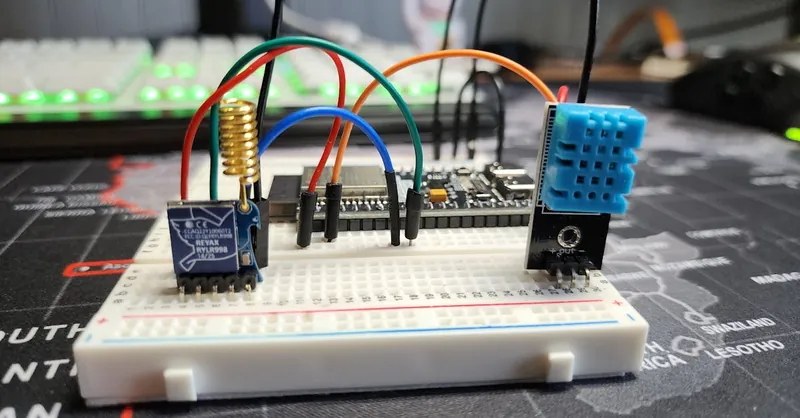
Image courtesy of Bmonster Lab
Advanced Embedded Systems Projects Leveraging AI and IoT Integration
As embedded systems evolve, integrating Artificial Intelligence (AI) and Internet of Things (IoT) capabilities into microcontroller projects unlocks powerful new dimensions of smart automation, predictive analytics, and seamless connectivity. Advanced embedded projects now commonly feature machine learning inference on resource-constrained microcontrollers, combined with robust IoT communication protocols and cloud-based data management to deliver intelligent, responsive systems. This fusion enables developers to build applications such as smart home assistants, predictive maintenance tools, environmental analytics platforms, and autonomous control solutions with real-time decision-making.
Key Areas of Focus for AI and IoT-Enabled Microcontroller Projects
-
Machine Learning on Microcontrollers (TinyML):
Leveraging frameworks like TensorFlow Lite for Microcontrollers or Edge Impulse, you can deploy compact neural networks capable of tasks such as gesture recognition, anomaly detection, or voice command processing directly on platforms like the ESP32 or STM32. These projects teach you how to optimize model size, preprocess sensor data efficiently, and implement inference code in C/C++ or Python, maintaining low power consumption while enhancing system intelligence. -
IoT Connectivity and Protocols:
Integrating WiFi, Bluetooth Low Energy (BLE), LoRaWAN, or NB-IoT modules enables your embedded system to become part of a wider ecosystem, exchanging data securely with cloud services and remote applications. Mastery of IoT communication protocols including MQTT, CoAP, and HTTPS is essential for building scalable and reliable smart systems that collect, transmit, and react to real-time data. -
Cloud Integration and Data Analytics:
Advanced projects push beyond local processing by connecting microcontrollers to cloud platforms like AWS IoT, Azure IoT Hub, or Google Cloud IoT Core. This setup facilitates remote monitoring, control, firmware updates over-the-air (FOTA), and big data analytics. Implementing end-to-end security, data serialization (JSON, Protocol Buffers), and efficient network management are critical skills developed here.
Examples of Advanced Embedded AI and IoT Projects
-
Smart Energy Management System:
Combine sensors monitoring electricity usage with embedded ML models predicting consumption patterns, and cloud dashboards providing remote control and alerts for energy optimization in homes or buildings. -
Predictive Maintenance for Industrial Equipment:
Embed vibration and temperature sensors with anomaly detection algorithms on microcontrollers, transmitting suspicious activity data via MQTT to cloud servers for maintenance scheduling before failures occur. -
Voice-Activated Home Automation Hub:
Utilize on-device speech recognition models to interpret voice commands while managing IoT appliance control through MQTT messaging, enabling responsive and private home automation.
Benefits of Embracing AI and IoT in Embedded Systems
- Smarter decision-making at the edge reduces latency and dependence on continuous network connectivity.
- Enables scalable IoT ecosystems with interoperable devices communicating securely across protocols and platforms.
- Enhances your professional embedded development portfolio with in-demand skills in AI model deployment, IoT networking, and cloud integration.
By advancing into projects that blend machine learning inference on microcontrollers with robust IoT communication and cloud services, you elevate your embedded systems expertise to the forefront of modern technology trends. This enables you to build connected, intelligent solutions that respond dynamically to real-world conditions while maintaining efficiency and scalability.

Image courtesy of Kindel Media
Programming Strategies in Python and C/C++ for Embedded Systems
Effective programming in Python and C/C++ is pivotal for developing high-performance, reliable microcontroller embedded systems. Understanding best practices, code optimization techniques, and cross-language interoperability ensures your projects run efficiently within the stringent resource constraints typical of embedded platforms like Raspberry Pi and ARM-based MCUs.
Best Practices for Embedded Programming
-
Write Modular, Readable Code:
Break your application into clear, reusable modules or functions. This enhances maintainability and allows easier debugging, especially when working with complex embedded systems involving multiple peripherals and communication interfaces. -
Optimize Memory Usage:
Since embedded devices often possess limited RAM and storage, use data types carefully (e.g., preferuint8_toverintwhere appropriate), minimize global variables, and leverage static memory allocation when possible to avoid fragmentation and runtime overhead. -
Employ Efficient I/O Handling:
Avoid costly blocking calls; instead, use interrupt-driven programming or polling with timeouts to handle peripherals. This preserves CPU cycles and improves real-time responsiveness. -
Implement Robust Error Handling:
Embedded systems frequently interact with noisy sensors and external components prone to failure. Incorporating error checking, timeouts, and recovery routines is essential to maintain system stability and predictability.
Code Optimization Techniques
- Use Inline Functions and Macros in C/C++: Reduces function call overhead while keeping code size manageable.
- Minimize Floating-Point Operations: When possible, replace floating-point calculations with fixed-point arithmetic to accelerate processing.
- Leverage Compiler Optimization Flags: Use levels like
-O2or-Osduring compilation to optimize code speed or size respectively without sacrificing readability. - Profile and Benchmark: Utilize tools such as hardware timers and debuggers to identify bottlenecks, enabling targeted optimizations.
Cross-Language Interoperability Between Python and C/C++
Embedded projects often benefit from combining Python’s rapid development capabilities with C/C++’s execution efficiency, especially on platforms like Raspberry Pi where both environments coexist.
-
Writing C Libraries for Python Extensions:
Performance-critical routines can be implemented in C or C++, compiled as shared libraries, and seamlessly called from Python via bindings (e.g., usingctypes,cffi, orSWIG). This approach marries high-level code flexibility with low-level speed. -
MicroPython and CircuitPython:
For resource-limited microcontrollers, running Python dialects like MicroPython provides embedded scripting, while allowing easy interfacing with low-level C modules for hardware control. -
Serial and Network-Based Communication:
When Python and C/C++ code run on separate processors or cores, inter-language communication over UART, SPI, or TCP/IP maintains modularity and leverages the strengths of each language effectively.
Adopting these programming strategies enhances your embedded system projects by producing clean, efficient, and maintainable codebases capable of operating within embedded constraints. Mastery of Python and C/C++ interplay unlocks advanced development workflows, empowering you to create innovative, performant embedded applications on platforms such as Raspberry Pi and beyond.

Image courtesy of Christina Morillo
Power Management and Optimization Techniques for Embedded Designs
Designing energy-efficient embedded systems is crucial for extending battery life, reducing heat dissipation, and enabling portable or remote applications. Effective power management strategies revolve around leveraging the microcontroller’s capabilities, optimizing hardware, and implementing intelligent software controls to minimize energy consumption without sacrificing performance. Whether you are working on a Raspberry Pi Pico, ESP32, or an ARM Cortex MCU, applying power optimization techniques enhances the sustainability and reliability of your embedded projects.
Key Power Management Techniques
-
Utilize Low-Power Modes:
Most modern microcontrollers offer multiple low-power or sleep modes (e.g., standby, stop, idle) that disable unused peripherals and reduce clock speeds, significantly lowering current draw. Smart firmware designs toggle between active and low-power states based on system activity or sensor input, maximizing efficiency during idle periods. -
Implement Battery Management Strategies:
For portable embedded systems, integrating efficient battery management ICs (BMICs) for charging control, voltage regulation, and protection is essential. Using fuel gauge sensors helps monitor battery health and capacity accurately, enabling predictive alerts and graceful system shutdowns. Selecting the right battery technology (Li-ion, LiPo, NiMH) and balancing discharge rates with system demands also impact overall energy longevity. -
Optimize Hardware Selection and Design:
Choosing ultra-low-power components such as sensors with sleep modes, voltage regulators with high efficiency, and LEDs with appropriate current ratings avoids unnecessary power waste. Minimizing external circuitry and using energy-saving communication interfaces (e.g., BLE instead of classic Bluetooth) further drive down system consumption. -
Software-Level Optimization:
Code must be tailored to reduce CPU load by avoiding busy waiting, using interrupts instead of polling, and implementing dynamic frequency scaling where possible. Techniques like debouncing inputs in software and batching sensor readings reduce wake-ups and processor cycles, conserving precious power.
Practical Tips to Boost Embedded System Efficiency
- Disable Unused Peripherals: Temporarily switch off ADCs, UARTs, SPI interfaces, or PWM channels when not in use.
- Use DMA (Direct Memory Access): Offload data transfer tasks from the CPU to lower energy-consuming DMA controllers.
- Choose Efficient Communication Protocols: Use power-conscious standards (e.g., Zigbee, LoRaWAN) for wireless data transmission.
- Apply Hardware Timers and RTCs: Let hardware timers perform periodic wake-ups or maintain real-time clocks without constant CPU intervention.
By integrating these power management and optimization techniques into your embedded systems design workflow, you create smarter, longer-lasting microcontroller projects suitable for real-world applications ranging from wearable devices to environmental monitoring stations. These strategies not only enhance the sustainability of your devices but also cultivate invaluable skills in embedded systems energy efficiency — a highly sought-after niche in modern electronics development.

Image courtesy of Manny
Debugging and Testing Methods for Reliable Embedded System Projects
Ensuring reliability and robustness in your microcontroller embedded systems demands a structured approach to debugging and testing. Embedded environments pose unique challenges such as limited visibility into runtime behavior, constrained resources, and real-time constraints. Adopting systematic debugging, unit testing, and validation methodologies is crucial to identify faults early, improve code quality, and guarantee stable operation in the field.
Systematic Debugging Approaches
-
Use On-Board Debuggers and Breakpoints:
Modern microcontrollers often support hardware debugging via tools like JTAG, SWD, or built-in debug probes. Leveraging breakpoints, step-through execution, and watch variables enables granular inspection of program flow and peripheral states without intrusive logging. -
Implement Serial and LED-Based Diagnostics:
For resource-constrained devices lacking advanced debuggers, strategic use of serial output (UART) logs and indicator LEDs can provide lightweight insight into program status, error codes, or execution checkpoints. -
Leverage Logic Analyzers and Oscilloscopes:
Monitoring digital signals, communication protocols (SPI, I2C, UART), and timing behavior with external tools helps diagnose hardware faults and timing issues invisible to software alone.
Unit Testing and Continuous Validation
-
Modular Unit Testing:
Break down firmware into independent, testable functions or modules and write unit tests that simulate hardware behavior through mocks or stubs. Frameworks such as Unity or CppUTest facilitate automated, repeatable testing in C/C++ environments. -
Hardware-in-the-Loop (HIL) Testing:
Combine software simulations with actual embedded hardware to verify peripheral interactions and timing-sensitive operations under realistic conditions, reducing deployment risks. -
Regression Testing:
Maintain a suite of tests that run on every code change to detect unintended side effects early, supporting continuous integration practices even in embedded projects.
Ensuring Robustness in Embedded Applications
-
Incorporate Defensive Programming:
Use assertions, boundary checks, and error handlers to gracefully manage unexpected inputs or hardware failures. -
Watchdog Timers and Fail-Safe Mechanisms:
Deploy watchdog timers to recover from software hangs, and design fallback states to ensure system safety during faults. -
Stress Testing Under Realistic Conditions:
Validate performance and stability by simulating extreme environmental factors such as voltage fluctuations, temperature variations, and noisy sensor inputs to harden your embedded application.
By embedding these debugging and testing best practices into your development lifecycle, you markedly increase the reliability and maintainability of your embedded systems. This meticulous attention to validation not only minimizes costly field failures but also enhances your skills in producing professional-grade microcontroller projects optimized for real-world performance.

Image courtesy of Mikhail Nilov
Case Studies of Creative Real-World Embedded Projects
Analyzing exemplary embedded microcontroller projects from both community-driven initiatives and industry applications offers invaluable insights into how innovative designs harness microcontrollers to solve practical challenges. These case studies demonstrate the diversity of embedded systems, from compact sensor networks to complex autonomous machines, highlighting the versatility and power of microcontrollers in real-world scenarios.
1. Smart Agricultural Monitoring System
In a recent community project focused on sustainable farming, developers utilized ESP32 microcontrollers combined with a suite of environmental sensors (soil moisture, temperature, humidity, and light) to build a smart agricultural monitoring system. By integrating LoRaWAN communication protocols, the system wirelessly transmits sensor data to a centralized gateway, enabling farmers to monitor field conditions remotely and optimize irrigation schedules.
Key features:
- Low-power operation using deep sleep modes to maintain extended battery life
- Real-time data logging with edge analytics to trigger immediate alerts
- Modular sensor arrays easily expandable to suit various crop types
This project exemplifies how embedded microcontrollers facilitate low-cost, scalable IoT solutions in agriculture, blending sensor data acquisition, power management, and efficient wireless communication for precision farming.
2. Autonomous Delivery Robot
In the industrial sector, an autonomous delivery robot leverages an STM32 microcontroller for real-time sensor fusion and motor control. The embedded system integrates inputs from LiDAR, ultrasonic sensors, and wheel encoders, executing algorithms for path planning and obstacle avoidance in dynamic environments. The firmware, primarily developed in C++, optimizes the microcontroller’s performance for strict real-time constraints while communicating with a Raspberry Pi companion computer via UART for high-level decision-making.
Highlights include:
- Interrupt-driven sensor processing to maintain millisecond-level responsiveness
- PWM-based motor speed and steering control circuits for smooth navigation
- Robust fault-tolerant design with watchdog timers and system health monitoring
This example underscores the critical role of embedded microcontrollers in robotic autonomy, where precise sensor integration, real-time control, and cross-platform communication converge to create intelligent, reliable systems.
3. Wearable Health Monitoring Device
A product developed by a startup demonstrates how wearable technology employs a Nordic nRF52 series MCU with integrated Bluetooth Low Energy (BLE) to continuously track vital signs like heart rate and blood oxygen saturation. Embedded firmware designed in C prioritizes low power consumption and secure data transfer to paired smartphones. Additionally, on-chip digital signal processing filters noisy sensor data, enhancing accuracy.
Project innovations:
- Custom power-saving algorithms extending battery life beyond 24 hours
- Firmware-over-the-air (FOTA) update capabilities to deploy new features remotely
- Embedded encryption for HIPAA-compliant data privacy
This case study illustrates how microcontrollers are foundational in healthcare wearables, combining compact size, wireless connectivity, and secure, low-latency data processing to deliver user-centric health insights.
These case studies highlight the broad spectrum of microcontroller applications and the innovative techniques employed to tailor embedded systems for specialized uses. Whether facilitating smart agriculture, enabling autonomous robotics, or advancing wearable medical devices, successful projects share core principles of efficient hardware-software co-design, real-time responsiveness, and integrated communication protocols, inspiring developers to push the boundaries of embedded system creativity.

Image courtesy of Pavel Danilyuk
Resources and Communities to Support Your Embedded Systems Development
Navigating the complex world of microcontroller embedded systems development is greatly eased by tapping into rich online resources, vibrant communities, comprehensive documentation, and open-source projects and tutorials. These platforms not only help you troubleshoot challenges but also keep your skills sharp, expose you to cutting-edge techniques, and inspire new project ideas—crucial for sustained growth in programming with Python, C/C++, and embedded system frameworks on Raspberry Pi and other microcontrollers.
Essential Online Forums and Discussion Platforms
-
Stack Overflow
A bustling Q&A hub where embedded developers ask precise programming questions related to microcontrollers, embedded C/C++, Python, hardware interfacing, and debugging. Utilizing tags likeembedded,microcontroller, or specific board names (e.g.,raspberry-pi-pico) helps you find relevant topics and answers quickly. -
Raspberry Pi Forums
The official Raspberry Pi community offers specialized sections for embedded systems projects, hardware hacking, and programming, making it invaluable for projects centered on Raspberry Pi and its microcontroller offshoots. -
Arduino Forum
A dedicated space for Arduino enthusiasts, covering beginner to advanced conversations about sensors, actuators, communication protocols, and code optimization in C/C++. -
Reddit Communities
Subreddits like r/embedded, r/microcontrollers, and r/raspberry_pi foster peer support, project showcases, and discussions about best practices and new tools in microcontroller programming and embedded design.
Comprehensive Documentation and Open-Source Libraries
-
Microcontroller Manufacturer Resources
Access datasheets, reference manuals, and application notes from leading MCU manufacturers such as STMicroelectronics (STM32), Espressif (ESP32), Nordic Semiconductor (nRF52), and Microchip (AVR/Arduino). These documents provide vital specifications and usage guidelines foundational to professional embedded design. -
GitHub and GitLab Repositories
Explore an expansive ecosystem of open-source firmware, sensor drivers, and embedded applications that can be cloned, modified, or studied. Projects like PlatformIO Examples or Awesome Embedded Systems aggregators provide high-quality codebases and inspiration. -
Tutorial Aggregators and Learning Platforms
Websites such as Embedded.com, Hackster.io, and Adafruit Learning System deliver step-by-step tutorials ranging from basic microcontroller interfacing to sophisticated IoT and AI integration projects.
Continuous Learning and Skill Sharpening Tools
-
Online Courses
Platforms like Coursera, Udemy, and edX offer embedded systems courses tailored for various skill levels, often covering microcontroller architecture, firmware development with C/C++, real-time operating systems (RTOS), and embedded Linux on Raspberry Pi. -
Simulators and Emulators
Tools such as MPLAB X Simulator or QEMU for ARM microcontrollers allow you to prototype and debug embedded code virtually, accelerating development cycles without requiring constant hardware access. -
Community Challenges and Hackathons
Participation in events hosted by organizations like Hackaday or local maker spaces encourages hands-on practice, collaboration, and exposure to diverse embedded system approaches.
By leveraging these resources and communities, you position yourself for ongoing success in embedded systems development. They not only provide the technical support and knowledge base essential for rigorous development but also connect you to a global network of innovators passionate about Raspberry Pi, microcontrollers, and embedded programming in Python, C, and C++. Staying actively engaged accelerates learning, fosters creativity, and keeps you ahead in this rapidly evolving field.
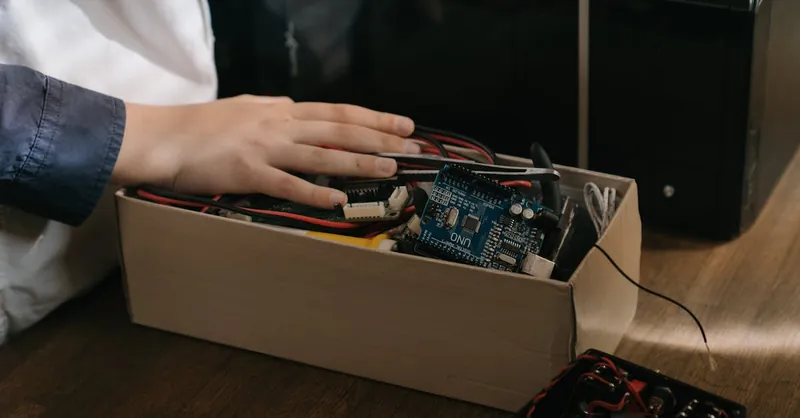
Image courtesy of cottonbro studio
